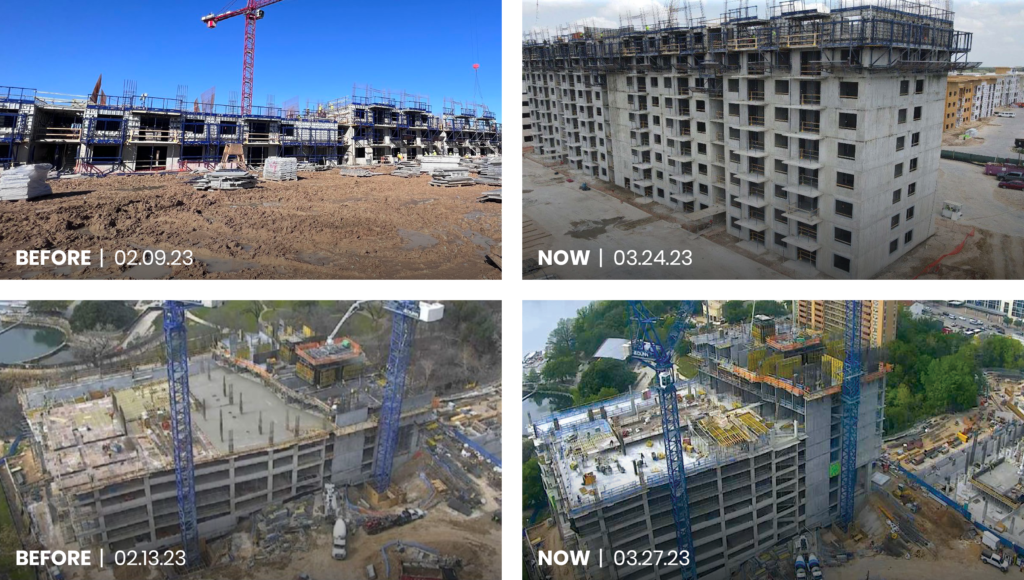
The construction industry is constantly in search of greater efficiency. Time, labor, and materials are all measured in dollars — the less you use, the less you spend. Concrete construction is associated with sheer mass: giant, heavy structures requiring enormous effort and large quantities of raw materials. An option is available, however, for building concrete structures more affordably, efficiently, and with fewer materials.
What is Thin Shell Construction?
In general, thin shell is a construction method that utilizes a monolithic thin concrete design with the structural integrity to resist external forces such as wind, rain, and other environmental stresses. These structures are often used to construct buildings and bridges, most commonly made from concrete. This means using slabs as thin as five inches to incorporate electrical work and rebar during the casting process.
Rather than using traditional plywood concrete forms, which are prone to water absorption and warping and can be reused only a few times at most, thin shell formwork technology utilizes lightweight metal and plastic composite forms, which can withstand upwards of 3,500 pours without losing their integrity. The result is a better-finished product with fewer flaws that will ultimately last longer, allowing a thinner slab to do the same job as a thicker one. In addition, thin shells can be constructed both in-situ (on-site) and prefabricated (off-site) depending on the design and needs of the project.
What Would Thin Shell Replace?
Tunnel form is an earlier iteration of the ideas behind thin shell that has been in use for over 50 years. Utilizing a series of square steel “tunnel” forms — picture a row of upside-down shoe boxes lined up with narrow gaps in between — walls and slabs can be poured in place in a highly efficient and systematic way on a daily cycle. The upside is that the steel forms are reusable up to 600 times, and the structures created are well-formed and very stable, even under earthquake conditions. The downside is that this method limits you to very heavy, boxy, repetitive structures with little design flexibility, and one wall must be left out during the pour to allow for the removal of the tunnel forms. That wall then must be finished later in the project by other methods. Additionally, a large crane is needed onsite to move the forms from unit to unit.
What are the Advantages of Thin Shell Construction?
Thin shell improves on tunnel form technology through modularity both in design and weight. Rather than large tunnel forms, smaller portable pieces are used to form up the room on all four sides. When finished, the forms can be broken down and removed through the remaining openings in the building (doors and windows), leaving behind all of the exterior and interior walls and slabs in place with no holes that need to be covered later. The individual form work pieces can be assembled in many different ways, equating to an infinite number of designs that utilize the same form work pieces.
Thin shell construction is strong enough to construct buildings to unlimited heights, and the thinner slabs often make it possible to reduce the overall height of a building without sacrificing ceiling height between any of the floors.
Thin shell also requires fewer tasks than traditional methods. Since most of those processes are completed during the pour, less skilled labor is needed for coring and other installation services. Thin shell is frequently used in developing countries due to its simplicity and repeatability. Fewer materials and less labor mean greater safety and sustainability. Many form work designs incorporate railings, catwalks, and other safety features that work with the system on-site without additional materials or labor.
The savings in materials and manpower equate to savings in time, making thin shell buildings faster to construct without sacrificing safety or quality. Faster construction means the project owners can earn revenue from their buildings even sooner. The efficiency of thin shell construction also makes it possible to use concrete in projects that use less durable materials, offering better fire protection, weather resistance, and strength and possibly lower insurance costs.
Add in the fact that the modular design options are more flexible, and the modern formwork creates a more consistent and aesthetically pleasing result. This multi-faceted construction method truly offers much to desire.
Sky Dancing Consulting Associates is one of the most experienced companies in the world utilizing this method, having designed for thin shell construction since 1983. SCA has executed numerous projects throughout the U.S. and abroad for industries ranging from commercial to industrial and financial to healthcare. If you would like to know what benefits Thin Shell construction can provide to your next project, contact Brock Shepard shepardb@scaengineers.com or Ron Krauss kraussr@scaengineers.com at SCA for more information.
